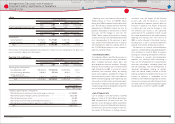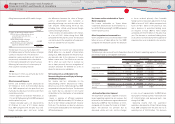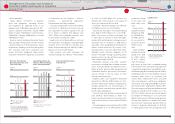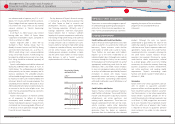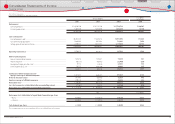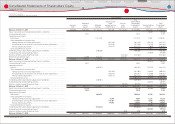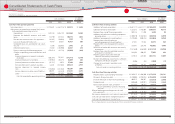Toyota 2010 Annual Report Download - page 59
Download and view the complete annual report
Please find page 59 of the 2010 Toyota annual report below. You can navigate through the pages in the report by either clicking on the pages listed below, or by using the keyword search tool below to find specific information within the annual report.
57
TOYOTA ANNUAL REPORT 2010
Critical accounting estimates
assets, and requires additional disclosures about
transfers of fi nancial assets. This guidance is
eff ective for fi scal year beginning after November
15, 2009, and for interim period within the fi scal
year. Management is evaluating the impact of
adopting this guidance on Toyotas consolidated
fi nancial statements.
In June 2009, FASB issued updated guidance of
accounting for and disclosure of consolidation.
This guidance changes how a company
determines when a variable interest entity
should be consolidated. This guidance is eff ective
for fi scal year beginning after November 15,
2009, and for interim period within the fi scal
year. Management is evaluating the impact of
adopting this guidance on Toyotas consolidated
fi nancial statements.
The consolidated fi nancial statements of Toyota
are prepared in conformity with accounting
principles generally accepted in the United States
of America. The preparation of these fi nancial
statements requires the use of estimates,
judgments and assumptions that aff ect the
reported amounts of assets and liabilities at the
date of the fi nancial statements and the reported
amounts of revenues and expenses during the
periods presented. Toyota believes that of its
signifi cant accounting policies, the following
may involve a higher degree of judgments,
estimates and assumptions:
Product Warranty
Toyota generally warrants its products against
certain manufacturing and other defects.
Product warranties are provided for specifi c
periods of time and/or usage of the product and
vary depending upon the nature of the product,
the geographic location of the sale and other
factors. All product warranties are consistent
with commercial practices. Toyota includes a
provision for estimated product warranty costs
as a component of cost of sales at the time the
related sale is recognized. The accrued warranty
costs represent managements best estimate
at the time of sale of the total costs that Toyota
will incur to repair or replace product parts that
fail while still under warranty. The amount of
accrued estimated warranty costs is primarily
based on historical experience of product
failures as well as current information on repair
costs. The amount of warranty costs accrued
also contains an estimate of warranty claim
recoveries to be received from suppliers. The
foregoing evaluations are inherently uncertain,
as they require material estimates and some
products warranties extend for several years.
Consequently, actual warranty costs may diff er
from the estimated amounts and could require
additional warranty provisions. If these factors
require a signifi cant increase in Toyotas accrued
estimated warranty costs, it would negatively
aff ect future operating results of the automotive
operations.
Toyota accrues for costs of recalls and other
safety measures based on managements
estimates when it is probable a liability has
been incurred and the amount of loss can be
reasonably estimated. Prior to the fourth quarter
of this fi scal year, amounts were accrued based
on individual occurrences of recalls and other
safety measures. During the fourth quarter of this
consolidated fi scal year, as a result of signifi cant
changes in facts and circumstances, Toyota has
employed an estimation model, to accrue at the
time of vehicle sale, an amount that represents
managements best estimate of expenses related
to future recalls and other safety measures. The
estimation model for recalls and other safety
measures takes into account Toyotas historical
experience and individual occurrences of recalls
and other safety measures. This change resulted
from Toyotas most recent experience with
recalls and other safety measures, changes in the
operating processes such as the establishment
of the Special Committee for Global Quality to
address quality-related matters, as well as the
broadening of the number of vehicles subject to
recalls and other safety measures. Consequently,
actual costs of recalls and other safety measures
may diff er from the estimated amounts.
Allowance for Doubtful Accounts
and Credit Losses
Natures of estimates and assumptions
Sales fi nancing and fi nance lease receivables
consist of retail installment sales contracts
secured by passenger cars and commercial
vehicles. Collectability risks include consumer
and dealer insolvencies and insuffi cient collateral
values (less costs to sell) to realize the full
carrying values of these receivables. As a matter
of policy, Toyota maintains an allowance for
doubtful accounts and credit losses representing
managements estimate of the amount of asset
impairment in the portfolios of fi nance, trade
and other receivables. Toyota determines the
allowance for doubtful accounts and credit
losses based on a systematic, ongoing review
and evaluation performed as part of the credit-
risk evaluation process, historical loss experience,
the size and composition of the portfolios,
current economic events and conditions, the
estimated fair value, adequacy of collateral
and other pertinent factors. This evaluation is
inherently judgmental and requires material
estimates, including the amounts and timing
of future cash fl ows expected to be received,
which may be susceptible to signifi cant change.
Although management considers the allowance
for doubtful accounts and credit losses to
be adequate based on information currently
available, additional provisions may be necessary
due to (i) changes in management estimates
and assumptions about asset impairments, (ii)
information that indicates changes in expected
future cash fl ows, or (iii) changes in economic
and other events and conditions. To the extent
that sales incentives remain an integral part of
sales promotion with the eff ect of reducing new
vehicle prices, resale prices of used vehicles and,
correspondingly, the collateral value of Toyotas
sales fi nancing and fi nance lease receivables
could experience further downward pressure.
If these factors require a signifi cant increase
in Toyotas allowance for doubtful accounts
and credit losses, it could negatively aff ect
future operating results of the fi nancial services
operations. The level of credit losses, which has a
greater impact on Toyotas results of operations,
is infl uenced primarily by two factors: frequency
of occurrence and severity of loss. For evaluation
purposes, exposures to credit loss are segmented
into the two primary categories of consumer
and dealer. Toyotas consumer portfolio consists
of smaller balances that are homogenous retail
fi nance receivables and lease earning assets.
The dealer portfolio consists of wholesale and
other dealer fi nancing receivables. The overall
Financial Section
Financial Section
Investor Information
Corporate Information
Special Feature
Consolidated
Performance Highlights
Business Overview
Top Messages
Management's Discussion and Analysis of
Financial Condition and Results of Operations




